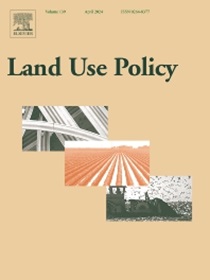Multi-scenario simulation of low-carbon land use based on the SD-FLUS model in Changsha, China
IF 6
1区 社会学
Q1 ENVIRONMENTAL STUDIES
引用次数: 0
Abstract
The significance of land use in relation to carbon emissions cannot be overstated. Consequently, enhancing the structure of land use can concurrently decrease carbon emissions and improve land utilization efficiency. However, the majority of studies have primarily concentrated on static linear planning analysis, overlooking how land use spatial structure affects carbon emissions. There is still relatively limited research on the integrated simulation and optimization of land use, considering both low-carbon objectives and economic benefits. This study focuses on Changsha, simulating land use change and net carbon emissions coupling the SD (system dynamics) model with the FLUS (future land use simulation) model in three different scenarios, namely, Baseline Development (BD), Rapid Economic Development (RED), Coordinated Development (CD). The following are the key findings. Firstly, the integrated model demonstrates precision in predicting land use demands, patterns, and net carbon emissions. Secondly, land use demands in three different scenarios have a similar changing tendency by 2030. Farmland, grassland, and water areas are decreasing, while forestland, unused land, and built-up land are expanding at different rates. The land use patterns in the CD scenario are the most desirable compare to the other scenarios. The growth rate of built-up land has slowed down and is distributed in a compact manner, while the growth of forest land is faster and has a contiguous layout. The overall degree of landscape fragmentation has decreased, and different land types are distributed in a more balanced manner. This has led to a gradual decrease in net carbon emissions after reaching a peak in 2021, with a reduction of 2.43 million tons compared to 2020. According to these findings, the government should adjust land use structure while optimizing the economic development model to minimize carbon emissions, which enables us to provide a planning strategy for land use and sustainable development of China's major cities.
基于 SD-FLUS 模型的中国长沙低碳土地利用多情景模拟
土地利用对碳排放的重要性怎么强调都不为过。因此,改善土地利用结构可以同时减少碳排放和提高土地利用效率。然而,大多数研究主要集中于静态线性规划分析,忽略了土地利用空间结构对碳排放的影响。在兼顾低碳目标和经济效益的前提下,对土地利用进行综合模拟和优化的研究还相对有限。本研究以长沙市为研究对象,在基线发展(BD)、经济快速发展(RED)、协调发展(CD)三种不同情景下,将 SD(系统动力学)模型与 FLUS(未来土地利用模拟)模型相结合,模拟土地利用变化和净碳排放。以下是主要研究结果。首先,综合模型在预测土地利用需求、模式和净碳排放方面表现出了精确性。其次,到 2030 年,三种不同情景下的土地利用需求具有相似的变化趋势。耕地、草地和水域面积在减少,而林地、未利用地和建筑用地在以不同的速度扩大。与其他情景相比,CD 情景下的土地利用模式最为理想。建设用地的增长速度放缓,分布紧凑,而林地的增长速度较快,布局连片。景观破碎化的总体程度有所降低,不同土地类型的分布更加均衡。这使得净碳排放量在 2021 年达到峰值后逐步下降,与 2020 年相比减少了 243 万吨。根据这些研究结果,政府应在优化经济发展模式的同时调整土地利用结构,最大限度地减少碳排放,从而为中国主要城市的土地利用和可持续发展提供规划策略。
本文章由计算机程序翻译,如有差异,请以英文原文为准。
求助全文
约1分钟内获得全文
求助全文
来源期刊

Land Use Policy
ENVIRONMENTAL STUDIES-
CiteScore
13.70
自引率
8.50%
发文量
553
期刊介绍:
Land Use Policy is an international and interdisciplinary journal concerned with the social, economic, political, legal, physical and planning aspects of urban and rural land use.
Land Use Policy examines issues in geography, agriculture, forestry, irrigation, environmental conservation, housing, urban development and transport in both developed and developing countries through major refereed articles and shorter viewpoint pieces.
 求助内容:
求助内容: 应助结果提醒方式:
应助结果提醒方式:


